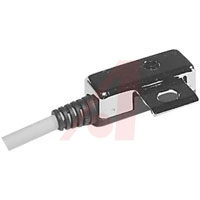D-F59L -
SENSOR, PNEUMATIC, NCA1 CYLINDER, 4.5-24VDC POWER, 40MA NPN OUT, 3M CABLE
- 制造商产品编号:
- D-F59L
- 仓库库存编号:
- 70070570
由于产品数据库庞大,部分产品信息可能未能及时更新,下单前请与销售人员确认好实时在库数量,谢谢合作!
D-F59L产品概述
One type of proximity switch is an enclosed reed switch that is activated by a permanent magnet mounted to the piston. As the piston approaches, the magnetic field closes the switch, completing an electric circuit and producing an electric signal. Others prefer to use Hall-effect (Solid-State) sensors in combination with a piston-mounted magnet. The main difference between these two devices is that a reed switch is a mechanical device, while a Hall-effect (Solid-State) switch is electronic, with no moving parts to wear out. Reed switches have the advantage of operating on AC or DC current; Hall-effect (Solid-State) switches are limited to DC only. Also, reed switches are about half the price of their electronic counterpart, although the price differential is decreasing. On the other hand, Hall-effect (Solid-State) devices react much faster than reed switches, on the order of 100,000 versus 500 Hz. It is a waste of money to install microprocessor-based logic, and then be hampered by a slow switch. Overall, the trend seems to be towards these solid-state devices. Both switches have a repeatability of 0.005" or less. But often rod velocity, not switch accuracy, determines the overall repeatability of rod position. Because air is a compressible fluid, precise positioning of the cylinder rod -- especially in midstroke -- is difficult, regardless of the switch used. In many applications, even if the switch is very fast and accurate, getting the valves to react fast enough may be the real problem. In such cases, mounting fast-acting valves as close to the cylinder as possible is important. This eliminates excess compressible air in the lines between cylinder and flow control, giving more precise control. Note: Switch mounting hardware sold separately.


 Datasheet
Datasheet